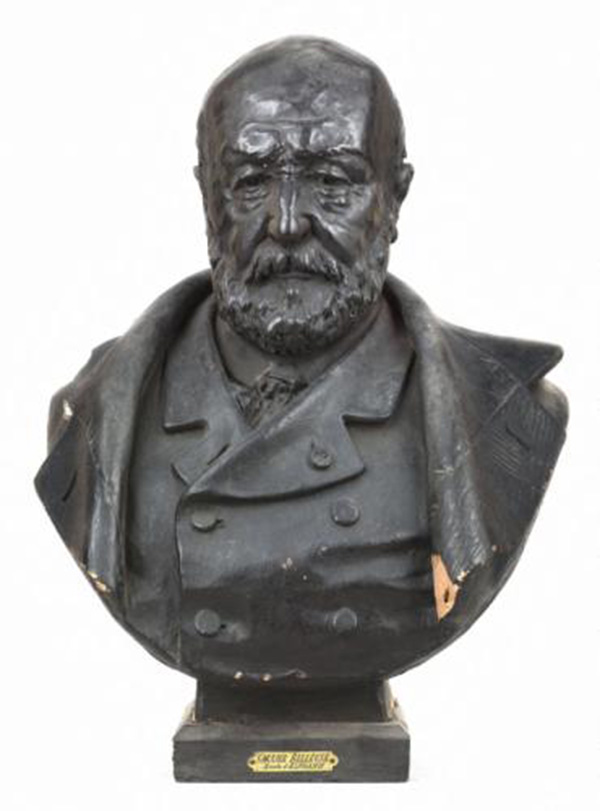Louis-Robert Carrier-Belleuse
Download PDFAlternately painter, sculptor, ceramist and bronzier, Louis-Robert Carrier-Belleuse was born in 1848 and died in 1913 in Paris. He was the brother of the painter and pastellist Pierre Carrier-Belleuse and the son of the renowned sculptor Albert-Ernest Carrier-Belleuse, and, like him, handled "with the same happiness the brush, the grater and the chisel."
He began at thirteen years old in a bronzier workshop where he educated himself as chisel and smelter. Very quickly, he worked the day at Barbedienne workshop, while he devotes his evenings at the School of fine arts’ courses in Paris. It is there that he will take the classes of Gustave Boulanger (1824-1888) and Alexandre Cabanel (1823-1889), after having also studied with his father. He started at the Salon of 1870 as a painter with a painting called La Lettre (The Letter). The next year, he became soldier in the Franco-Prussian war against the Germans and against the Commune, then tokke its activity again, in 1875.
Theodore Deck (1823-1891) introduced Carrier-Belleuse to ceramics in 1877, at the Maison Deck, at Vaugirard, an experiment which determinated his future path. He participated in the Sèvres competition in 1882 where he presented a Planter, project that was bought by the government for the Sèvres porcelain factory and could be the Project kept at the Musée d'Orsay. In parallel, he worked at the Sèvres porcelain factory with his father, who was the director of art since 1875, and for who he made artistic drawings.
Louis-Robert is then the designer of models for the Faïencerie de Choisy-le-Roi which played an important role in the 19th century in the field of art ceramics. This factory collaborated with important artists including Chaplet, Dammouse, Albert-Ernest and Louis-Robert Carrier-Belleuse, who became artistic director in 1889.
At the Faïencerie de Choisy-le-Roi, he created his famous Vase Sauve qui peut (Every man for himself Vase) whose th few copies are today very populair. He presented the plaster of this vase for the first time at the National Society of Fine Arts Salon of 1896 and at the Salon of 1898 in sandstone, with three other vases: Hercules and Omphale, Children and Butterflies and Music.
Children and Butterflies, produced several times, was acquired in 2003 by the Petit Palais. It is thus one of the rare examples of a vase by this artist conserved in a public French collection: although his works, sculptures, as ceramics and paintings, circulate a lot on the art market, the museums keeps rather some of his paintings.
While in painting Carrier-Belleuse mainly represented the trades of his time, like Porteurs de farine (Porters of flour), dated 1885, which refers to the life of the Halles in Paris, or Une équipe de bitumiers (A Team of asphalt workers), bought at the time by the Luxembourg museum, Carrier-Belleuse gave in these vases phantasmagoric representations. He thus made putti carved in relief in animated postures his speciality. We find these restless putti on the Vase La lutte pour la vie (The fight for life), kept at the Petit Palais also. To create these reliefs, Carrier-Belleuse used the technique called "pâte sur pâte" ("paste on paste"). This process, developed at the Manufacture de Sèvres around 1848, was usually used by sculptors, which obviously echoes the initial training of Carrier-Belleuse, painter, but also sculptor.
During his career, Carrier-Belleuse received two "honourable mention" : one during the Salon de la Société des Artistes Francais (Salon of Society of French Artists) in 1881, as a painter, for his painting titled Un étameur (A Tinner), and one during the Salon of 1889, as a sculptor, with his Monument in memory of J. Rufino and Potrait of Madame de B ... in terracotta. 1889 is also the year he exhibited for the first time in the sculpture section. In 1896, he was awarded a third class medal, in the section of applied art, with The Republic of Costa Rica. Carrier-Belleuse has indeed made several projects for Costa Rica, which enjoyed at the time a real nationalist and sovereignist movement against foreign invaders came during the 19th century to conquer Central America. His Costa Rica National Monument is today one of the most popular monuments in the country. At the same time, he was present at some Salons of the National Society of Fine Arts (SNBA). He exhibited for the last time in 1912.
Active artist in the life of his time, he was a member of the Société des Artistes Francais, then, in the last years of his life, he was attaché to the Civil Court of the Seine as an expert. He also received the Legion of Honor in 1900. A worthy heir of his father, to whom he is often compared, he is indubitably a great artist in his own right which is evidence by his place in the art market.
















